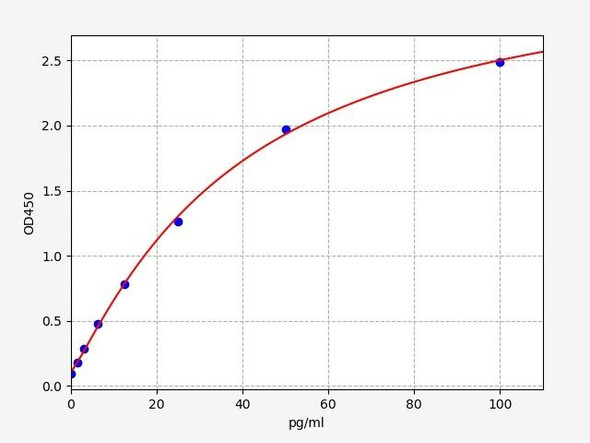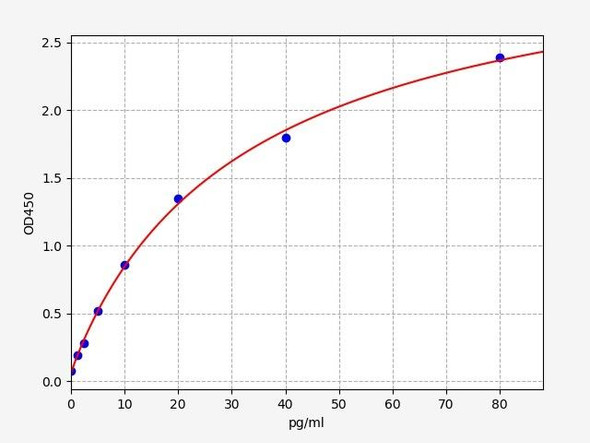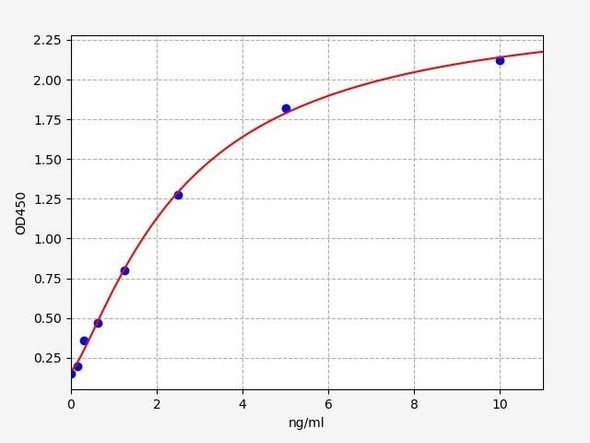Human Endothelin-3 (EDN3) ELISA Kit (HUEB2186)
- SKU:
- HUEB2186
- Product Type:
- ELISA Kit
- Size:
- 96 Assays
- Uniprot:
- P14138
- Range:
- 78-5000 pg/mL
- ELISA Type:
- Sandwich
- Synonyms:
- EDN3, endothelin 3, endothelin-3, ET3, ET-3, HSCR4, PPET3, preproendothelin-3, Preproendothelin-3, truncated endothelin 3, WS4B
- Reactivity:
- Human
Description
Human Endothelin-3 (EDN3) ELISA Kit
The Human Endothelin-3 (EDN3) ELISA Kit is specifically designed for the accurate quantification of Endothelin-3 levels in human serum, plasma, and cell culture supernatants. This kit offers high sensitivity and specificity, ensuring precise and reproducible results that are suitable for a variety of research purposes.Endothelin-3 is a key peptide involved in regulating blood vessel constriction and relaxation, playing a crucial role in endothelial function and cardiovascular health.
Dysregulation of Endothelin-3 levels has been linked to various vascular disorders, making it a valuable biomarker for studying these conditions and potentially developing targeted therapeutic interventions. With its advanced technology and reliable performance, the Human Endothelin-3 (EDN3) ELISA Kit is an essential tool for researchers and clinicians looking to investigate the role of Endothelin-3 in health and disease.
| Product Name: | Human Endothelin-3 (EDN3) ELISA Kit |
| SKU: | HUEB2186 |
| Size: | 96T |
| Target: | Human Endothelin-3 (EDN3) |
| Synonyms: | Preproendothelin-3, PPET3, ET-3 |
| Assay Type: | Sandwich |
| Detection Method: | ELISA |
| Reactivity: | Human |
| Detection Range: | 78-5000pg/mL |
| Sensitivity: | 33pg/mL |
| Intra CV: | 4.7% | ||||||||||||||||||||
| Inter CV: | 6.9% | ||||||||||||||||||||
| Linearity: |
| ||||||||||||||||||||
| Recovery: |
| ||||||||||||||||||||
| Function: | Endothelins are endothelium-derived vasoconstrictor peptides. |
| Uniprot: | P14138 |
| Sample Type: | Serum, plasma, tissue homogenates, cell culture supernates and other biological fluids |
| Specificity: | Natural and recombinant human Endothelin-3 |
| Research Area: | Cardiovascular |
| Subcellular Location: | Secreted |
| Storage: | Please see kit components below for exact storage details |
| Note: | For research use only |
| UniProt Protein Function: | EDN3: Endothelins are endothelium-derived vasoconstrictor peptides. Defects in EDN3 are the cause of Hirschsprung disease type 4 (HSCR4); also known as aganglionic megacolon (MGC). A genetic disorder of neural crest development characterized by the absence of intramural ganglion cells in the hindgut; often resulting in intestinal obstruction. Defects in EDN3 are a cause of congenital central hypoventilation syndrome (CCHS); also known as congenital failure of autonomic control or Ondine curse. CCHS is a rare disorder characterized by abnormal control of respiration in the absence of neuromuscular or lung disease, or an identifiable brain stem lesion. A deficiency in autonomic control of respiration results in inadequate or negligible ventilatory and arousal responses to hypercapnia and hypoxemia. Defects in EDN3 are a cause of Waardenburg syndrome type 4 (WS4B); also known as Waardenburg-Shah syndrome. WS4B is characterized by the association of Waardenburg features (depigmentation and deafness) and the absence of enteric ganglia in the distal part of the intestine (Hirschsprung disease). Belongs to the endothelin/sarafotoxin family. 3 isoforms of the human protein are produced by alternative splicing. |
| UniProt Protein Details: | Protein type:Secreted; Secreted, signal peptide Chromosomal Location of Human Ortholog: 20q13.2-q13.3 Cellular Component: extracellular space; extracellular region Molecular Function:hormone activity; receptor binding Biological Process: regulation of systemic arterial blood pressure by endothelin; blood circulation; multicellular organismal development; positive regulation of leukocyte chemotaxis; signal transduction; vein smooth muscle contraction; neuron differentiation; positive regulation of MAP kinase activity; cell surface receptor linked signal transduction; cell-cell signaling; melanocyte differentiation; positive regulation of cell proliferation; neural crest cell migration; artery smooth muscle contraction; vasoconstriction; neutrophil chemotaxis; inositol phosphate-mediated signaling; positive regulation of mitosis; positive regulation of hormone secretion; positive regulation of heart rate; peptide hormone secretion; cellular calcium ion homeostasis; regulation of gene expression; regulation of vasoconstriction; regulation of pigmentation during development; positive regulation of cell differentiation Disease: Hirschsprung Disease, Susceptibility To, 4; Waardenburg Syndrome, Type 4b; Central Hypoventilation Syndrome, Congenital |
| NCBI Summary: | The protein encoded by this gene is a member of the endothelin family. Endothelins are endothelium-derived vasoactive peptides involved in a variety of biological functions. The active form of this protein is a 21 amino acid peptide processed from the precursor protein. The active peptide is a ligand for endothelin receptor type B (EDNRB). The interaction of this endothelin with EDNRB is essential for development of neural crest-derived cell lineages, such as melanocytes and enteric neurons. Mutations in this gene and EDNRB have been associated with Hirschsprung disease (HSCR) and Waardenburg syndrome (WS), which are congenital disorders involving neural crest-derived cells. Altered expression of this gene is implicated in tumorigenesis. Alternative splicing results in multiple transcript variants encoding different isoforms. [provided by RefSeq, Oct 2014] |
| UniProt Code: | P14138 |
| NCBI GenInfo Identifier: | 119618 |
| NCBI Gene ID: | 1908 |
| NCBI Accession: | P14138.1 |
| UniProt Secondary Accession: | P14138,Q03229, Q7Z6D2, Q9UGT7, E1P5I5, |
| UniProt Related Accession: | P14138 |
| Molecular Weight: | 23,596 Da |
| NCBI Full Name: | Endothelin-3 |
| NCBI Synonym Full Names: | endothelin 3 |
| NCBI Official Symbol: | EDN3 |
| NCBI Official Synonym Symbols: | ET3; ET-3; WS4B; HSCR4; PPET3 |
| NCBI Protein Information: | endothelin-3; preproendothelin-3 |
| UniProt Protein Name: | Endothelin-3 |
| UniProt Synonym Protein Names: | Preproendothelin-3; PPET3 |
| Protein Family: | Endothelin |
| UniProt Gene Name: | EDN3 |
| UniProt Entry Name: | EDN3_HUMAN |
| Component | Quantity (96 Assays) | Storage |
| ELISA Microplate (Dismountable) | 8×12 strips | -20°C |
| Lyophilized Standard | 2 | -20°C |
| Sample Diluent | 20ml | -20°C |
| Assay Diluent A | 10mL | -20°C |
| Assay Diluent B | 10mL | -20°C |
| Detection Reagent A | 120µL | -20°C |
| Detection Reagent B | 120µL | -20°C |
| Wash Buffer | 30mL | 4°C |
| Substrate | 10mL | 4°C |
| Stop Solution | 10mL | 4°C |
| Plate Sealer | 5 | - |
Other materials and equipment required:
- Microplate reader with 450 nm wavelength filter
- Multichannel Pipette, Pipette, microcentrifuge tubes and disposable pipette tips
- Incubator
- Deionized or distilled water
- Absorbent paper
- Buffer resevoir
*Note: The below protocol is a sample protocol. Protocols are specific to each batch/lot. For the correct instructions please follow the protocol included in your kit.
Allow all reagents to reach room temperature (Please do not dissolve the reagents at 37°C directly). All the reagents should be mixed thoroughly by gently swirling before pipetting. Avoid foaming. Keep appropriate numbers of strips for 1 experiment and remove extra strips from microtiter plate. Removed strips should be resealed and stored at -20°C until the kits expiry date. Prepare all reagents, working standards and samples as directed in the previous sections. Please predict the concentration before assaying. If values for these are not within the range of the standard curve, users must determine the optimal sample dilutions for their experiments. We recommend running all samples in duplicate.
| Step | |
| 1. | Add Sample: Add 100µL of Standard, Blank, or Sample per well. The blank well is added with Sample diluent. Solutions are added to the bottom of micro ELISA plate well, avoid inside wall touching and foaming as possible. Mix it gently. Cover the plate with sealer we provided. Incubate for 120 minutes at 37°C. |
| 2. | Remove the liquid from each well, don't wash. Add 100µL of Detection Reagent A working solution to each well. Cover with the Plate sealer. Gently tap the plate to ensure thorough mixing. Incubate for 1 hour at 37°C. Note: if Detection Reagent A appears cloudy warm to room temperature until solution is uniform. |
| 3. | Aspirate each well and wash, repeating the process three times. Wash by filling each well with Wash Buffer (approximately 400µL) (a squirt bottle, multi-channel pipette,manifold dispenser or automated washer are needed). Complete removal of liquid at each step is essential. After the last wash, completely remove remaining Wash Buffer by aspirating or decanting. Invert the plate and pat it against thick clean absorbent paper. |
| 4. | Add 100µL of Detection Reagent B working solution to each well. Cover with the Plate sealer. Incubate for 60 minutes at 37°C. |
| 5. | Repeat the wash process for five times as conducted in step 3. |
| 6. | Add 90µL of Substrate Solution to each well. Cover with a new Plate sealer and incubate for 10-20 minutes at 37°C. Protect the plate from light. The reaction time can be shortened or extended according to the actual color change, but this should not exceed more than 30 minutes. When apparent gradient appears in standard wells, user should terminatethe reaction. |
| 7. | Add 50µL of Stop Solution to each well. If color change does not appear uniform, gently tap the plate to ensure thorough mixing. |
| 8. | Determine the optical density (OD value) of each well at once, using a micro-plate reader set to 450 nm. User should open the micro-plate reader in advance, preheat the instrument, and set the testing parameters. |
| 9. | After experiment, store all reagents according to the specified storage temperature respectively until their expiry. |
When carrying out an ELISA assay it is important to prepare your samples in order to achieve the best possible results. Below we have a list of procedures for the preparation of samples for different sample types.
| Sample Type | Protocol |
| Serum | If using serum separator tubes, allow samples to clot for 30 minutes at room temperature. Centrifuge for 10 minutes at 1,000x g. Collect the serum fraction and assay promptly or aliquot and store the samples at -80°C. Avoid multiple freeze-thaw cycles. If serum separator tubes are not being used, allow samples to clot overnight at 2-8°C. Centrifuge for 10 minutes at 1,000x g. Remove serum and assay promptly or aliquot and store the samples at -80°C. Avoid multiple freeze-thaw cycles. |
| Plasma | Collect plasma using EDTA or heparin as an anticoagulant. Centrifuge samples at 4°C for 15 mins at 1000 × g within 30 mins of collection. Collect the plasma fraction and assay promptly or aliquot and store the samples at -80°C. Avoid multiple freeze-thaw cycles. Note: Over haemolysed samples are not suitable for use with this kit. |
| Urine & Cerebrospinal Fluid | Collect the urine (mid-stream) in a sterile container, centrifuge for 20 mins at 2000-3000 rpm. Remove supernatant and assay immediately. If any precipitation is detected, repeat the centrifugation step. A similar protocol can be used for cerebrospinal fluid. |
| Cell culture supernatant | Collect the cell culture media by pipette, followed by centrifugation at 4°C for 20 mins at 1500 rpm. Collect the clear supernatant and assay immediately. |
| Cell lysates | Solubilize cells in lysis buffer and allow to sit on ice for 30 minutes. Centrifuge tubes at 14,000 x g for 5 minutes to remove insoluble material. Aliquot the supernatant into a new tube and discard the remaining whole cell extract. Quantify total protein concentration using a total protein assay. Assay immediately or aliquot and store at ≤ -20 °C. |
| Tissue homogenates | The preparation of tissue homogenates will vary depending upon tissue type. Rinse tissue with 1X PBS to remove excess blood & homogenize in 20ml of 1X PBS (including protease inhibitors) and store overnight at ≤ -20°C. Two freeze-thaw cycles are required to break the cell membranes. To further disrupt the cell membranes you can sonicate the samples. Centrifuge homogenates for 5 mins at 5000xg. Remove the supernatant and assay immediately or aliquot and store at -20°C or -80°C. |
| Tissue lysates | Rinse tissue with PBS, cut into 1-2 mm pieces, and homogenize with a tissue homogenizer in PBS. Add an equal volume of RIPA buffer containing protease inhibitors and lyse tissues at room temperature for 30 minutes with gentle agitation. Centrifuge to remove debris. Quantify total protein concentration using a total protein assay. Assay immediately or aliquot and store at ≤ -20 °C. |
| Breast Milk | Collect milk samples and centrifuge at 10,000 x g for 60 min at 4°C. Aliquot the supernatant and assay. For long term use, store samples at -80°C. Minimize freeze/thaw cycles. |










